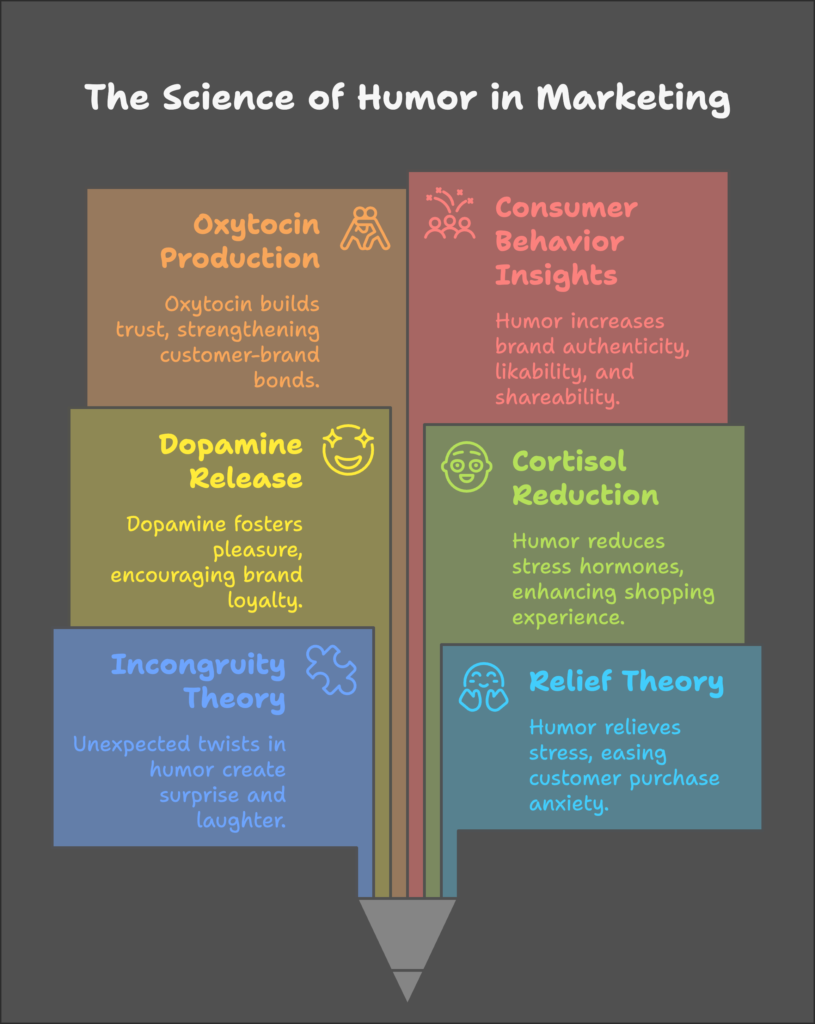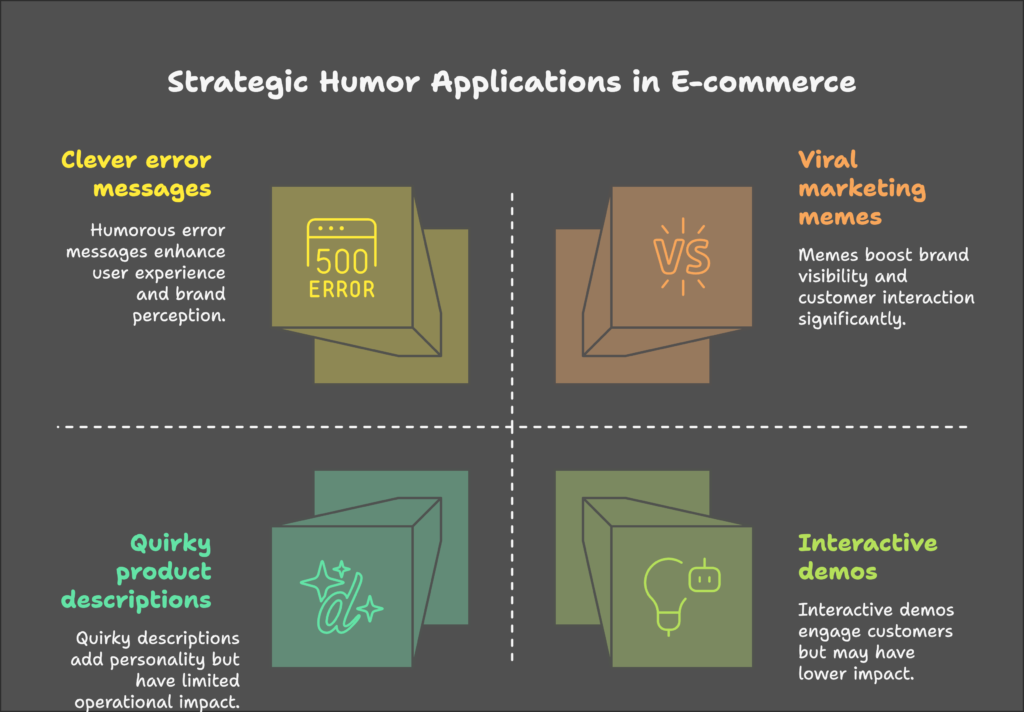Ever scrolled past dozens of boring product descriptions only to stop and chuckle at one that actually made you laugh? Did you end up spending more time on that page—maybe even clicking “add to cart”? If so, you’ve experienced firsthand the powerful effect of humor in e-commerce.
In a digital marketplace crowded with countless options and competitors just a click away, the brands that stand out aren’t just selling products—they’re creating memorable experiences. And nothing creates a memorable experience quite like a well-timed joke or a bit of clever wordplay.
By reading this article, you’ll discover:
- Why humor dramatically increases consumer engagement and sales (with the science to back it up)
- Practical strategies to incorporate humor into every aspect of your e-commerce business
- How to avoid common pitfalls that can turn humor from an asset into a liability
- Real-world success stories from brands that laughed their way to higher conversions
Ready to transform your e-commerce content from forgettable to share-worthy? Let’s dive in and explore how strategic humor can become your competitive advantage!
Introduction to Humor in E-commerce
Have you noticed how shopping online has transformed from simply buying things to having experiences? This shift represents one of the most significant changes in consumer behavior in recent years. Today’s consumers don’t just want products—they want to feel connected to the brands they purchase from. And humor is proving to be one of the most effective bridges for building that connection.
The Role of Humor in Modern Consumer Engagement
The numbers don’t lie—humor gets results. Research shows that 61% of consumers are likely to share content that makes them laugh. Think about that for a moment. In an era where organic reach is increasingly difficult to achieve, humor can turn your customers into willing brand ambassadors who spread your message for free.
This shift from transactional to experiential shopping has fundamentally changed how successful e-commerce brands communicate. The sterile, feature-focused product descriptions of yesterday have given way to content that entertains as it informs.
Why Humor Matters in E-commerce
Beyond just getting a chuckle, humor serves several critical business functions:
- It builds emotional connections and trust. When you make someone laugh, you create an instant bond. This emotional connection translates directly into increased trust—a crucial factor in purchase decisions.
- It dramatically enhances memorability. Content infused with humor is remembered 22 times more than standard marketing messaging. In a sea of forgettable ads and product listings, being memorable is invaluable.
- It humanizes your brand. Behind every e-commerce store is a team of real people. Humor helps showcase the human side of your business, making customers feel like they’re buying from people, not an algorithm.
When customers feel this connection, they’re not just more likely to buy once—they’re more likely to become loyal, repeat customers who champion your brand to others.
Now that we understand why humor matters, you might be wondering exactly how it works on our brains. What makes something funny, and why do we respond to it so positively? Let’s explore the fascinating science behind humor’s effectiveness, shall we?
Psychological and Neurological Foundations of Humor
Ever wondered why certain jokes make us burst into laughter while others barely register a smile? The answer lies deep within our brains, where humor triggers a complex series of cognitive and neurochemical responses. Understanding these mechanisms can help you craft e-commerce content that resonates on a fundamentally human level.

Cognitive Mechanisms of Humor
Two primary theories explain how humor works in our minds:
- Incongruity Theory: This explains why unexpected twists make us laugh. Our brains love to predict patterns, and when those predictions are pleasantly violated—surprise!—we experience humor. Think about unboxing videos that take an unexpected turn or product descriptions with a surprising punchline.
- Relief Theory: Have you ever laughed during a stressful situation? That’s relief theory in action. Humor provides psychological relief from tension or stress—especially valuable in reducing the anxiety some customers feel when making purchase decisions.
These cognitive mechanisms don’t just entertain—they actively engage the brain, creating deeper neural pathways that enhance memory and emotional connection.
Neurochemical and Emotional Impact
When something makes us laugh, our brains become veritable chemical factories:
- Dopamine Release: This “feel-good” neurotransmitter creates pleasure and reinforces behavior. When customers associate your brand with dopamine-triggering humor, they’re more likely to return.
- Cortisol Reduction: Humor decreases stress hormones, creating a more positive shopping experience.
- Oxytocin Production: Often called the “trust hormone,” oxytocin strengthens social bonds—including the bond between customer and brand.
This cocktail of brain chemicals doesn’t just make customers feel good temporarily; it creates lasting positive associations with your brand.
Consumer Behavior Insights
These neurological responses translate directly into consumer behaviors that benefit e-commerce businesses:
- Increased Perceived Authenticity: Brands that use appropriate humor are viewed as more authentic and trustworthy.
- Enhanced Likability: We naturally gravitate toward people—and brands—that make us laugh.
- Viral Potential: Humorous content is shared at significantly higher rates than standard marketing materials.
Consider the case of Harmon Brothers’ campaigns for brands like Squatty Potty and Poo~Pourri. These products addressed potentially embarrassing topics through cleverly crafted humor, resulting in massive viral success and sales growth.
Now that we understand the “why” behind humor’s effectiveness, let’s explore the “how”—specific strategies for implementing humor across different aspects of your e-commerce business. Are you ready to turn these scientific insights into practical marketing tactics?
Strategic Applications of Humor in E-commerce
Now comes the fun part—putting humor to work in your e-commerce store! From product pages to customer service, strategic humor can transform every touchpoint of your customer’s journey. Let’s explore practical ways to infuse comedy into your business.

Product Page Optimization
Your product pages are prime real estate for humor that converts:
- Interactive Demos and Videos: Humorous product videos don’t just entertain—they boost engagement and clearly demonstrate benefits. Dollar Shave Club’s famous launch video didn’t just go viral; it helped build a business that eventually sold for $1 billion.
- Quirky Product Descriptions: Who says specifications have to be boring? Descriptive copy with personality can turn a standard product listing into an engaging experience. Consider how brands like Firebox add unexpected jokes to otherwise standard product details.
For example, instead of writing “This water bottle holds 20 ounces,” try “This mighty vessel holds enough water to keep you from turning into a human raisin during your workout.”
Marketing and Advertising
Your marketing campaigns offer countless opportunities to showcase your brand’s personality:
- Memes & Trending Formats: Leveraging popular meme formats shows your brand stays current. Remember how quickly companies adapted the Bernie Sanders mittens meme into their marketing? Those who acted fast saw engagement skyrocket.
- Pop Culture Integration: When Target responded to a viral tweet with their “compromise handshake” meme, they demonstrated both relevance and relatability.
The key is timeliness—humor that references current events or trends shows customers your brand is attentive and culturally aware.
Customer Service and UX Design
Even the most functional aspects of your store can benefit from strategic humor:
- Clever Error Messages: When something goes wrong, humor can defuse frustration. YouTube’s “trained monkeys” error page turns a potential moment of user annoyance into a smile.
- Gamification and Playful Interactions: Consider how Spotify Wrapped turns user data into a fun, shareable experience. Could your e-commerce store create similar engaging interactions?
Remember that these touchpoints offer opportunities to surprise and delight customers when they least expect it.
Social Media and Community Building
Your social presence is perhaps the most natural place to showcase humor:
- User-Generated Content Campaigns: Coca-Cola’s “Share a Coke” campaign encouraged users to create and share humorous content featuring their products.
- Live Streaming with Personality: Brands using humorous streamers see significant increases in purchase intent and brand affinity.
The beauty of social media humor is its ability to feel spontaneous and authentic, even when carefully planned.
We’ve covered the “where” of humor implementation, but the “how” matters just as much. Next, let’s explore frameworks for ensuring your humorous content hits the mark with your specific audience. After all, what’s hilarious to one customer might fall flat with another!
Frameworks for Effective Humor Implementation
Not all humor is created equal—especially when it comes to e-commerce. Successfully integrating comedy into your store requires understanding your audience, choosing appropriate content formats, and maintaining your brand identity. Let’s break down these critical frameworks.
Audience-Centric Strategies
The golden rule of humor in e-commerce: know who you’re talking to.
- Demographic Alignment: Different generations respond to different types of humor. Gen Z might appreciate absurdist memes and self-deprecating content, while Boomers might prefer more traditional wordplay and situational humor.
- Cultural Sensitivity: Humor doesn’t always translate across cultures. If you’re selling globally, ensure jokes work internationally or consider region-specific content. When Walmart tried to expand into Germany, their American-style greeting culture (including the smiley face) came across as insincere rather than friendly.
Before implementing any humorous content, ask yourself: “Will my specific customers find this genuinely funny, or might it miss the mark?”
Content Formats and Channels
Different platforms call for different approaches to humor:
- Video Content: Platforms like TikTok and Instagram Reels favor quick, visual humor. Old Spice’s absurdist ads worked brilliantly by combining unexpected visuals with rapid-fire jokes.
- Email Marketing: Email subject lines with humor see higher open rates, while cleverly funny content within emails can drive impressive conversion lifts. Punchline Copy, an agency specializing in humorous copywriting, consistently delivers double-digit conversion increases for clients.
- Chat and Messaging: Conversational interfaces allow for personalized humor that feels spontaneous—consider how chatbots might use contextual jokes to enhance customer service interactions.
The key is matching your humor style to both the capabilities and limitations of each format.
Balancing Humor and Brand Identity
Not every brand should sound like a stand-up comedian. Finding the right balance is crucial:
- Industry-Appropriate Humor: B2B and luxury brands might use more subtle wit, while lifestyle brands can often be more overtly playful.
- Consistency Across Touchpoints: Your humor should feel consistent with your overall brand voice. A joke that seems out of character can confuse customers rather than engage them.
Consider Finnish military gear store Varusteleka, which uses dark humor throughout its marketing. This approach perfectly matches both their products and target audience—military enthusiasts who appreciate no-nonsense communication with an edge.
While the potential benefits of humor are significant, they come with important considerations. In our next section, we’ll explore the potential pitfalls and ethical considerations to ensure your humorous content helps rather than harms your business. After all, a joke that backfires can do more damage than no joke at all!
Challenges and Ethical Considerations
Even the most well-intentioned humor can sometimes miss the mark. Understanding potential pitfalls and establishing ethical guidelines will help you implement humor that enhances—rather than damages—your brand reputation.
Risks of Misuse
When humor goes wrong, the consequences can be severe:
- Overstepping Boundaries: What seems funny internally might come across as insensitive to customers. Revlon learned this lesson when their tone-deaf campaigns failed to read the room during sensitive cultural moments.
- Cultural Pitfalls: Humor is deeply cultural, and what works in one market might offend in another. Walmart’s aforementioned failed German expansion demonstrates how cultural misunderstandings can undermine marketing efforts.
- Trivializing Important Issues: Using humor around serious topics requires exceptional care. A joke that seems to make light of important issues can alienate customers permanently.
The common thread? Humor requires context, and misjudging that context can turn a potential connection into a reputation crisis.
Ethical Guidelines
To avoid these pitfalls, establish clear guidelines for your humorous content:
- Avoid “Emotional Hijacking”: While humor creates powerful emotional responses, manipulating emotions purely for commercial gain can feel exploitative. Ensure your humor adds genuine value rather than simply triggering reactions.
- Transparency in Partnerships: If you’re working with influencers known for their humor, maintain transparency about sponsored content. Hidden commercial relationships can make humor feel inauthentic or manipulative.
- Punching Up, Not Down: The best commercial humor targets shared frustrations or pokes fun at the brand itself—never at vulnerable groups or individuals.
Consider creating an internal “humor review” process where diverse team members can evaluate potential jokes for unintended interpretations or problems.
Measuring Impact Without Exploitation
Even measurement practices around humor require ethical consideration:
- Balancing Metrics with Values: While humor might drive engagement, prioritize inclusive content over merely popular content. For example, ensure humorous content remains accessible to those using screen readers or translation services.
- Listening to Feedback: Create clear channels for customers to provide feedback on your humor. Genuine listening demonstrates respect and can prevent small issues from becoming larger problems.
Remember that ethical humor isn’t just morally right—it’s good business. Brands that maintain respectful, thoughtful humor build deeper trust than those constantly pushing boundaries for short-term attention.
With these ethical considerations in mind, you might wonder: how do we know if our humor is actually working? Let’s explore concrete methods for measuring humor’s effectiveness in your e-commerce business. After all, if you can’t measure it, how can you improve it?
Measuring Humor’s Effectiveness
Like any marketing strategy, humor should be measured and optimized over time. But how do you quantify something as subjective as humor? Let’s explore practical approaches to evaluating whether your funny content is delivering serious results.
Quantitative Metrics
The numbers can tell you much about humor’s impact:
- Engagement Rates: Humorous content typically drives 40% longer dwell time on pages. Monitor time on page, scroll depth, and interaction rates to gauge initial engagement.
- Conversion Metrics: The ultimate test is whether humor drives action. A/B test humorous vs. straightforward product descriptions, email subject lines, or CTAs to measure direct impact on conversions.
- Share and Virality Metrics: Track shares, mentions, and organic reach to assess how your humor resonates. If customers find content genuinely funny, they become willing distributors of your marketing.
Tools like Google Analytics, heat mapping software, and social listening platforms can help quantify these metrics systematically.
Qualitative Assessments
Numbers tell part of the story, but qualitative insights add crucial context:
- Sentiment Analysis: Use AI tools to analyze the emotional tone of comments and responses to your humorous content. Are people genuinely amused or merely acknowledging your attempt at humor?
- Customer Feedback: Direct surveys asking, “Did you find this content entertaining?” or “Did this approach make you more likely to purchase?” can provide straightforward insights.
- Focus Groups: For major campaigns, consider testing humor with representative audience segments before full launch.
These qualitative measures help explain the “why” behind your quantitative results.
Neuroscientific Tools
For brands with larger budgets, advanced measurement options exist:
- EEG Testing: Electroencephalography can measure brain responses to humorous content, offering insights into emotional valence beyond what customers might self-report.
- Eye-Tracking Studies: These reveal exactly where attention focuses during humorous content, helping optimize placement of key messages and CTAs.
While these methods were once available only to enterprise brands, more accessible versions are increasingly available to mid-sized e-commerce businesses.
Remember to measure humor’s long-term impact on brand perception, not just immediate sales. Many benefits of humorous content—like increased brand recall and affinity—might not translate to immediate purchases but still drive significant lifetime value.
Theory and measurement are valuable, but nothing illustrates humor’s potential like real-world examples. Let’s explore businesses that have successfully used humor to drive e-commerce growth—and the valuable lessons we can learn from those who missed the mark. Ready to see these principles in action?
Case Studies and Industry Examples
The true power of humor in e-commerce becomes clear when we examine real brands that have leveraged it successfully—and those that learned valuable lessons from humor gone wrong. Let’s look at some illuminating examples from the industry.
Success Stories
These brands turned laughter into commercial success:
- Dollar Shave Club: Perhaps the quintessential example of humor-driven e-commerce success. Their launch video, featuring founder Michael Dubin delivering deadpan humor about razor blades, generated 12,000 orders within 48 hours of launching. The company later sold to Unilever for $1 billion—proof that well-executed humor can build immense brand value.
- Chubbies: This men’s shorts brand built their entire identity around nostalgic, lighthearted humor that resonates with their millennial male audience. Their irreverent emails and social content have helped them grow from a small startup to a recognizable brand without traditional advertising.
- Nike x Colin Kaepernick: While addressing serious social issues, Nike’s campaign managed to incorporate subtle humor that made powerful points without alienating audiences. The campaign demonstrated how humor can complement rather than undermine important messages.
These success stories share a common thread: authenticity. In each case, the humor aligned perfectly with the brand’s overall identity and resonated specifically with their target audience.
Lessons from Failures
Not all attempts at commercial humor succeed:
- Heineken’s COVID Campaigns: Early in the pandemic, several brands including Heineken tried using humor that felt tone-deaf given the circumstances. The key lesson? Timing and context are everything for effective humor.
- Huawei’s Crisis Communications: When facing security concerns, Huawei’s attempts to use humor to deflect criticism backfired. Sometimes serious issues require serious responses, and humor can seem dismissive.
- Brands Jumping on Tragic News: Numerous brands have faced backlash for attempting to use humor tied to breaking news that turned out to be tragic. The lesson: patience and verification before attempting topical humor.
These missteps highlight the importance of reading the room, understanding context, and recognizing when humor is appropriate—and when it isn’t.
What’s particularly notable is how the internet never forgets. Unlike a failed joke in conversation that might be quickly forgotten, digital missteps live on. This makes thoughtful implementation of humor even more critical in e-commerce.
The world of online commerce continues to evolve rapidly. What humor trends should forward-thinking e-commerce brands prepare for? Let’s peek into the future of combining laughter with sales in our increasingly technological marketplace.
Future Trends and Innovations
The intersection of humor and e-commerce continues to evolve with emerging technologies and changing consumer preferences. Here’s a look at what’s on the horizon for brands looking to stay ahead of the curve.
AI-Driven Personalization
Artificial intelligence is transforming how brands create and deliver humorous content:
- Generative AI for Customized Humor: Emerging AI tools can tailor jokes and humorous content to individual preferences and past behavior. Imagine product descriptions that adjust their humor style based on whether a customer has responded positively to witty content in the past.
- Predictive Analytics for Trend Identification: AI can help brands identify emerging humor trends before they peak, allowing for more timely and relevant content. Systems that analyze social media can spot rising memes or joke formats with potential for brand adaptation.
While technology enables these possibilities, the most successful implementations will maintain the human touch that makes humor genuinely resonate.
Immersive Technologies
New media formats are creating novel opportunities for humorous engagement:
- AR/VR Humor Experiences: Augmented reality try-ons are evolving beyond utility to include elements of play and humor. Brands are creating amusing AR filters and experiences that entertain while showcasing products.
- Interactive Humor: Beyond passive consumption, interactive humor allows customers to participate in the joke. Meta’s Horizon Worlds and similar platforms are hosting branded comedy events where customers can engage directly with humorous content.
These immersive approaches create memorable experiences that standard product pages simply cannot match.
Ethical Evolution
As consumers become more aware of marketing techniques, ethical approaches to humor are evolving:
- Transparency in Neuromarketing: New EU regulations are requiring greater transparency around emotional marketing techniques, including humor designed to trigger specific psychological responses.
- Consumer Education: Forward-thinking brands are educating customers about how algorithmic content works, including how humorous content may be targeted to them based on behavior patterns.
Brands that embrace ethical innovation will build deeper trust while still benefiting from humor’s powerful effects.
Perhaps most interestingly, we’re seeing the rise of “value-aligned humor”—content that entertains while subtly reinforcing shared values between brand and customer. Rather than generic jokes, this approach uses humor to strengthen specific brand positioning around sustainability, inclusivity, or other core values.
We’ve covered extensive ground on using humor in your e-commerce business. Let’s bring these insights together and outline concrete steps for implementation in your own online store.
Conclusion and Recommendations
We’ve journeyed through the science, strategy, ethics, and future of humor in e-commerce. Now, let’s distill what we’ve learned into actionable recommendations for your business.
Key Takeaways
As we’ve seen throughout this exploration:
- Humor is a powerful psychological tool that triggers positive neurochemical responses, enhancing memory, trust, and emotional connection with your brand.
- Strategic humor can be applied across the customer journey—from product pages and marketing to customer service and community building.
- Effective humor requires careful consideration of your audience, brand identity, and ethical boundaries.
- Measurement matters—both quantitative and qualitative approaches help optimize your humorous content for maximum impact.
- The future of e-commerce humor is increasingly personalized, immersive, and aligned with brand values.
Perhaps most importantly, humor humanizes your brand in a digital landscape that can often feel cold and transactional. It transforms your e-commerce store from just another website into a memorable experience.
Actionable Steps
Ready to incorporate more strategic humor into your e-commerce business? Start with these concrete actions:
- Audit Your Current Content: Review your product descriptions, emails, and social media. Identify opportunities where appropriate humor could enhance the customer experience.
- Define Your Humor Guidelines: Document what types of humor align with your brand voice and audience expectations. Create clear boundaries for your team.
- Start Small and Test: Begin with low-risk implementations—perhaps a more playful order confirmation email or a slightly more conversational product description. Measure results before scaling.
- Collect Customer Feedback: Actively solicit opinions about your humorous content. Do customers find it genuinely funny? Does it enhance their perception of your brand?
- Build a Humor Toolbox: Collect examples, formats, and frameworks that work specifically for your brand and audience. This resource will help maintain consistency as you scale.
Remember to approach humor as an ongoing practice rather than a one-time campaign. The brands that benefit most develop a consistent voice that evolves naturally over time.
Final Thought
In an increasingly crowded e-commerce landscape, humor isn’t just nice to have—it’s a powerful differentiator. As we’ve explored throughout this article, when implemented thoughtfully, humor creates the authentic human connections that transform one-time purchasers into loyal brand advocates.
As the wise copywriter John Caples once noted, “People don’t buy from clowns.” True enough—but they do buy from brands that make them smile while solving their problems. Strategic humor helps your e-commerce business do exactly that.
Looking to boost your Shopify store’s performance? The Growth Suite app can help you implement many of the strategies discussed in this article, providing tools to enhance customer engagement and increase conversions. Check it out to take your e-commerce business to the next level!
References
- Hamelin & Harcar (2020): Neuroscience of humor in marketing. DOI:10.1504/IJIMA.2023.133344
- Social Stamina (2022): Memes and trending sounds. Link
- PopNeuro (2022): Psychology of humor. Link
- OMG Commerce (2018): Humor in conversion copywriting. Link
- LinkedIn (2024): Risk-free humor strategies. Link
- Full Moon Digital (2023): Benefits of humor in teams. Link
- CORE (2013): Humor as a marketing tool. PDF




